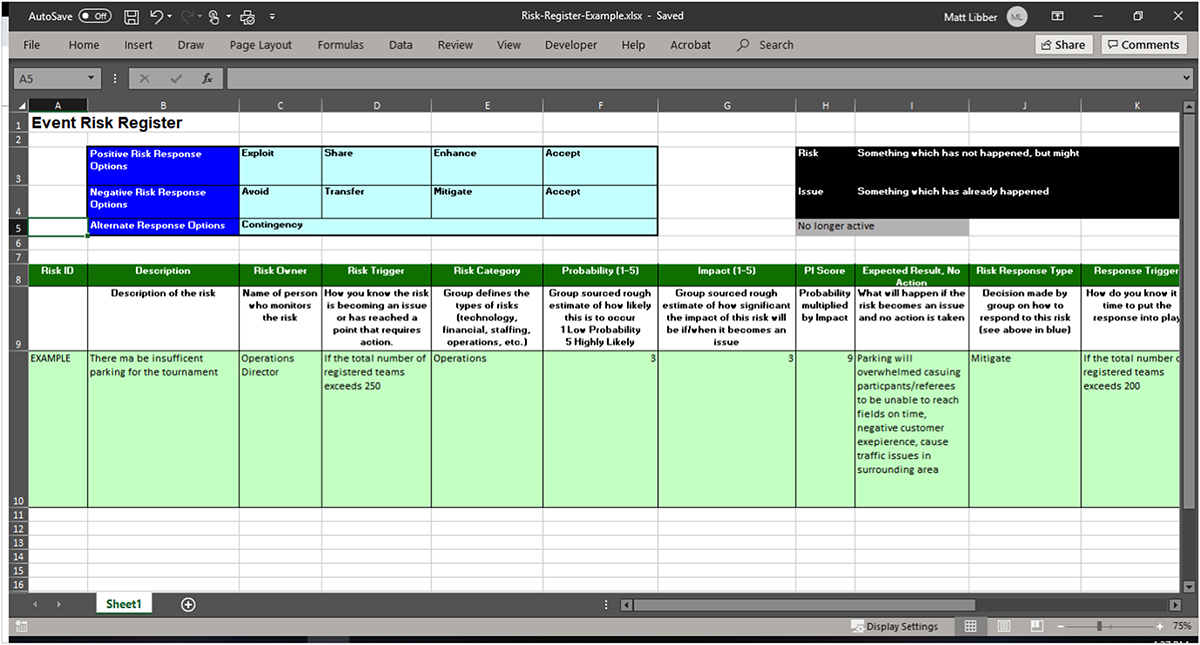

Risk management plans are multi-tiered in nature and cover everything from insurance to emergency action plans to crisis communications. All of the parts are intertwined in some fashion and there are a lot of stakeholders who need to be involved in development of a risk management plan.
Insurance
The most common thing that people think of when discussing risk management is insurance. Insurance is a vital piece of the overall plan and most likely, the easiest starting point for people in the sports industry. Insurance needs will vary from group to group and it is likely that no two policies will be the same for everyone. It is important to sit down with your insurance provider to talk about what your needs are and what type of coverage you may need.
At a minimum, you will need liability coverage for your events or facility. The amount of coverage may vary depending on the state in which you are located, the sport you are involved with and the number of people participating. There are numerous other policies to consider such as vehicle insurance for company cars or utility vehicles, event cancellation insurance, sexual abuse insurance for those operating in the youth space, and probably a dozen more to consider. You will need to individually evaluate the cost-benefit analysis for these policies to see what is right for you.
Background Checks
Anyone working in the youth athletics space should already be cognizant of the need to perform background checks on anyone who potentially will have contact with a minor. This has become common practice across the country for obvious reasons. However, not all background checks are created equal. Do your homework when looking for a company to do your background checks.
Some companies, for example, may rely solely on the National Criminal Information Center database operated by the FBI. Others may utilize state and local databases as well. In all of these cases, it is important to set your perimeters about what is acceptable and what is not when screening employees, coaches, staff and volunteers. Background check companies do not make decisions for you; they simply implement the policy that you establish.
 Risk Assessments
Risk Assessments
Risk assessments are necessary for all events and sports venues. These should be conducted on a regular basis and continually updated. Risk assessments are the process through which an event operator or facility owner will review all aspects of the event or facility to identify those areas that present a possible threat to an event. A threat is any man-made or natural occurrence that could potentially have a negative effect on the event in question. Common risks include potential weather incidents like snow or thunderstorms, and they escalate up to situations such as an active shooter.
Conducting risk assessments should involve a team of stakeholders to maximize the chance of identifying all the potential risks to an event. These stakeholders will commonly include the event director, facility director, security director, local police, fire and EMS. Depending on the event, you may need to involve federal entities such as Homeland Security or the FBI in the risk assessment process.
Each of these stakeholders will provide a different perspective on potential risks as well as insight on mitigation strategies. It is also important to not overlook the little things when doing a risk assessment. While in today’s world we are all worried about things like active shooters, it is also important to think about smaller scale issues like power or plumbing failures, lost children and traffic issues.

These smaller scale issues are far more likely to occur and, in some cases, may have a greater impact on your event – particularly if you are unprepared for them and don’t have a plan in place, should they occur. It is suggested that you develop a risk register (shown above) to track these risks and their mitigations. This will help make sure you are doing everything you can to minimize these risks as well as provide documentation support for other events you host or for the following year if you hold these same events at the same location.
Risk Mitigation
Once you have identified your risks during the assessment phase, you have to find ways to mitigate those risks. Some mitigations may be easy to fix and then close the risk on your risk register. For example, during your risk assessment, you may identify insufficient parking as a risk. Your mitigation strategy may be to provide satellite parking and a shuttle from a nearby shopping mall. It is important to understand that not all risks have solutions. Your mitigation strategy may reduce, but not eliminate, the threat. For example, you can plan to address how to handle adverse weather, but you cannot eliminate the chance of adverse weather occurring.
Risk mitigation is an ongoing process as circumstances evolve. Weather forecasts may improve as the event draws near but a new threat from emergency road construction near the entrance to the facility may arise. Your risk mitigation strategy should also be team-driven by your stakeholders. Having input from different people who have different backgrounds and perspective will help formulate stronger mitigation strategies.
Emergency Action Plan
An extension of the risk mitigation process is the development of an Emergency Action Plan or EAP. An EAP is a document that outlines the actions that should occur, should an emergency arise. There are several ways to develop an EAP. The plan may be specific to an event or facility, or it may be a general document that is modified before each event based on the specifics of that event.
The EAP should be used to identify those risks or issues that may occur during an event and provide an outline as to how to handle them. The EAP should include sections that identify stakeholders, chain of command, processes and procedures to address the issue at hand, a communication plan, and pre-scripted messaging. The EAP should cover large-scale issues like facility evacuations, active shooter scenarios and power outages as well as small-scale items that may be more likely, such as traffic issues, lost children or what to do if you are missing referees.
One area that is commonly overlooked is the pre-scripted messaging. The last thing you want to be doing during an emergency is trying to draft a message about the emergency. That is where you will see event organizers issuing incomplete or inaccurate messages because they are trying to address the issue while also drafting the message.
Training
The last step in the risk management process is training. You can identify all the risks, come up with a mitigation strategy and develop an emergency action plan, but none of it will be useful unless you train your staff. If you do not teach your staff the plan to address issues, the plan is useless. Far too many organizations spend time and money developing comprehensive plans just to have them sit on a shelf. It is only after disaster occurs when they realized they already planned for this but just didn’t tell anyone how to implement that plan.
Risk management may seem like a daunting task, but it is an essential aspect of running events or facilities. Risk management might just seem like extra work – until something goes wrong. Failure to properly address your risk management needs could be the end of your event or your business. Improper planning can open you up to liability and well as public relations issues. Each event or facility owner needs to address their specific needs in this area. In the end, it could turn what seems to be the end of everything into a success story. SDM

